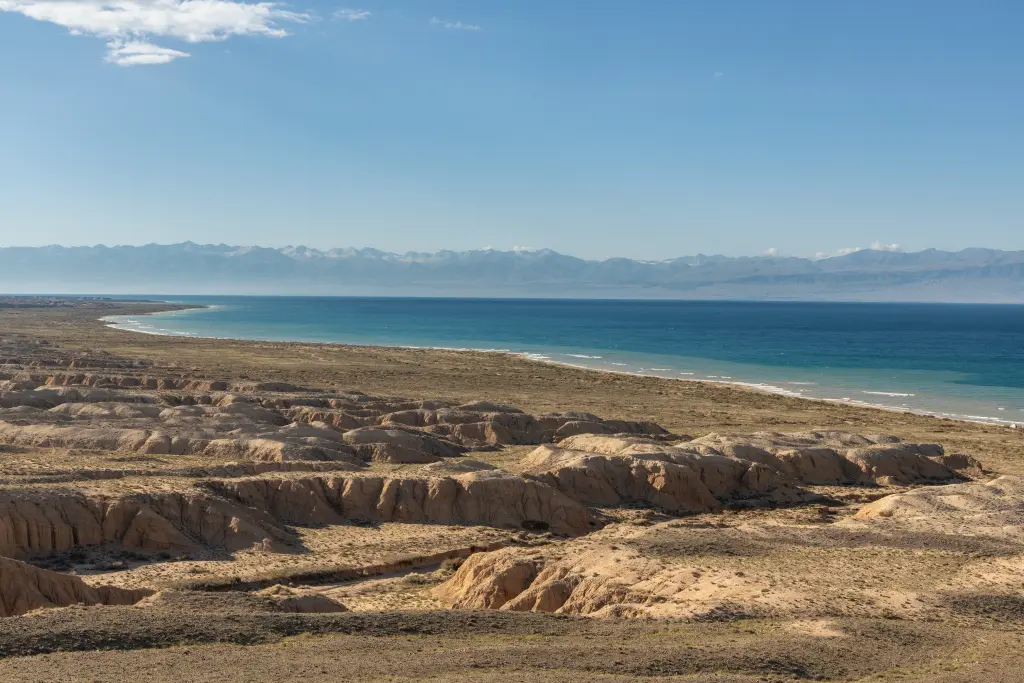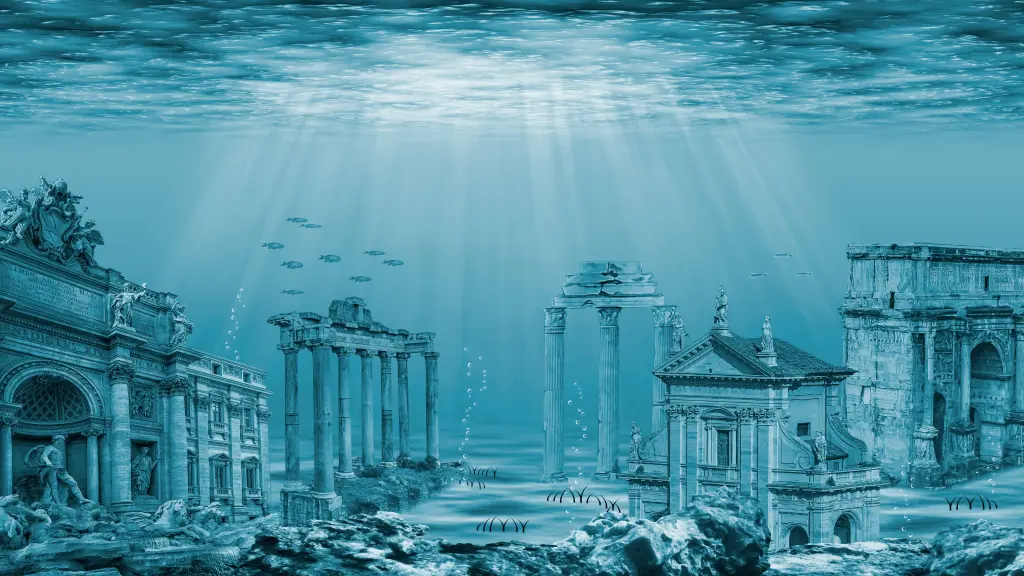A Lost Metropolis Beneath the Waves: Archaeologists Uncover a Mysterious Atlantis-Like City Hidden for Centuries Under Kyrgyzstan’s Lake Issyk Kul
For centuries, the legend of Atlantis has teased the edges of human imagination—an ancient world swallowed by water, its memory kept alive only through fragments passed down by philosophers and storytellers. Most dismissed the tale as a poetic exaggeration, a symbolic warning rather than a historical account. Yet every so often, the world offers a discovery that forces even the most skeptical minds to pause. That is exactly what has happened high in the Tien Shan mountains of Kyrgyzstan, where a team from the Russian Academy of Sciences has uncovered what they describe as “traces of a submerged city” lying silently beneath the cold, blue expanse of Lake Issyk Kul.

It is not just the headline that has captured global attention—but the way this discovery challenges long-held assumptions about Central Asian history, seismic catastrophes, and the possibility that ancient civilizations once flourished in places modern researchers had overlooked. Lake Issyk Kul, the world’s eighth deepest lake, has always been a place wrapped in myth. The name itself means “warm lake,” a nod to its rare ability to stay unfrozen even through harsh winters. Travelers along the ancient Silk Road wrote about the water’s uncanny calm, its shimmering surface reflecting snow-capped peaks and endless sky. But none imagined that beneath that stillness lay the remnants of a forgotten world.
According to official details released by the Russian Academy of Sciences, the submerged structures appear to date back to the medieval period and are believed to have been destroyed by a massive earthquake sometime in the 15th century. Earthquakes are not new to this region, which sits within one of Central Asia’s most active seismic zones. Historical manuscripts describe a powerful quake in the 1400s that devastated communities around the lake, but until now there had been no verified archaeological evidence of an entire settlement being lost beneath its waters.

That experience changed almost immediately when the first divers descended. The water was cold enough to sting their hands through gloves, visibility shifting with currents, but as beams of artificial light swept the lakebed, shapes began to emerge. What initially looked like natural rock formations revealed themselves to be straight lines, corners, and edges—forms not created by nature but by human hands. Divers reported toppled stone walls, a layout resembling streets or walkways, and fragments of ceramics still resting where they had fallen hundreds of years earlier. One diver surfaced carrying what appeared to be a sizeable ancient vessel, its surface encrusted with silt and time, but its shape remarkably intact.

Images shared by the academy—some of which circulated rapidly across global news platforms—show divers examining these artifacts with a mix of caution and awe. It is a moment researchers often dream of but rarely experience: a chance to touch something untouched by humanity for centuries.
Early analysis from historians connected with the project suggests the ruins may have belonged to a once-thriving trading settlement that served as a cultural bridge along the Silk Road. Lake Issyk Kul was a known waypoint for merchants traveling between the Middle East, China, and the Indian subcontinent. Its shores supported caravanserais, resting posts, and communities where languages, religions, and goods intertwined. Yet no written record explicitly mentions a city sinking into the lake, making this discovery all the more extraordinary.
The structures observed underwater do not resemble a single building but rather a cluster of them—stone foundations arranged in patterns that would have required deliberate urban planning. Some walls appear thicker than defensive structures seen in nearby historical sites, hinting at the need for protection or fortification. Archaeologists are cautious, noting that underwater measurements are still preliminary, but even conservative estimates position this settlement as far larger than previously assumed lake-edge villages.

Over the last decade, Issyk Kul has been a quiet hotspot for archaeological intrigue. Past explorations revealed Scythian burial mounds around the lake, petroglyphs dating back thousands of years, and hints of early Christian communities that existed long before much of the world realized Christianity had reached Central Asia. But nothing so far compares to the scale of this submerged site.
Local residents are not surprised, however—not entirely. Generations of Kyrgyz families grew up with stories about ancient cities hidden beneath Issyk Kul’s shimmering surface. Folklore described entire towns swallowed by divine anger or drowned due to moral decay—tales that echoed the universal myth of Atlantis. These oral traditions, often dismissed as exaggerated tales, now seem to carry grains of truth. For many villagers in the surrounding region, the discovery feels like vindication of narratives passed down through centuries.
But scientists are careful to draw a firm line between myth and reality. Researchers have not claimed any link to Plato’s Atlantis, and they emphasize that sensational comparisons are useful only for public imagination—not scientific analysis. What matters to them is uncovering the identity of the people who lived here, understanding the city’s layout, and documenting the forces of nature that ended its existence.
Based on preliminary studies, the leading theory is that a catastrophic earthquake—possibly accompanied by a sudden ground collapse—dragged the settlement downward, submerging it under what eventually became deeper lakewater. Sediment samples taken near the site support this timeline, showing layers consistent with rapid geological disruption around the 15th century.
“There is nothing more humbling,” one project researcher reportedly told regional media, “than realizing how many stories remain hidden beneath Earth’s surface, waiting for the right moment to resurface.” That sentiment captures why this discovery feels so monumental. It bridges modern science and ancient memory, geology and mythology, reminding the world how fragile civilizations are in the face of natural forces.
As the news spread internationally, historians and scientists from Europe, the U.S., and Central Asia expressed interest in collaborating on future dives and research papers. Underwater archaeology is notoriously complex—visibility, equipment limitations, and environmental regulations make every step slow. Yet this new site may prove to be one of the most significant underwater finds in Central Asia in decades.
Beyond scientific circles, the discovery has captured the fascination of everyday readers who see echoes of humanity’s oldest stories in this new evidence. The idea of a city lost beneath water touches something universal—the fear of nature’s unpredictability, the romance of lost civilizations, and the irresistible pull of secrets buried under centuries of silence.
In Kyrgyzstan, tourism officials predict renewed global interest in the region. Lake Issyk Kul has long been beloved for its beauty—mountains rising like guardians around its perimeter, water reflecting the sky like a sheet of turquoise glass. Now, it carries an added layer of mystery. Local guides are already imagining future boat tours that explain the archaeology beneath the waves, though researchers caution that preservation must come first.
For now, excavation is slow and methodical. Teams must plan each dive carefully, mapping structures and documenting artifacts without disturbing the site’s integrity. Every stone, shard, and submerged corner carries information. The city beneath Issyk Kul survived hundreds of years without human interference, and the scientists are determined to keep it intact even as they study it.
The broader global conversation triggered by this discovery feels almost poetic. In a world obsessed with technology and the future, here lies a reminder that the past still holds unsolved mysteries powerful enough to captivate millions. Whether people are drawn by the history, the science, or the mythic allure of an “Atlantis-like” world beneath the water, the result is the same: a renewed sense of wonder about our planet and the civilizations that once shaped it.
As more research emerges, experts stress that what has been uncovered so far is likely only a fraction of the settlement. Sediment may be covering additional structures lying deeper beneath the lakebed, and new imaging technologies—such as high-resolution sonar and underwater LIDAR—could reveal a far larger city than early divers have mapped.
And somewhere within that dark, cold water may lie answers to questions historians have asked for decades: Who built these structures? What led them to the shores of Issyk Kul? What trade routes connected them to the greater world? And how did they respond when the earth beneath them began to shake?
The story of the Issyk Kul metropolis is still being written. For now, only fragments have resurfaced—stones aligned in perfect geometry, pottery crafted by skilled hands, architectural remnants that speak of lives both ordinary and extraordinary. But those fragments are enough to remind humanity that the Earth still holds secrets capable of rewriting what we thought we knew.
The lake remains calm on the surface, but beneath it lies a city that whispers of a world lost to time, waiting patiently for its story to be told.



